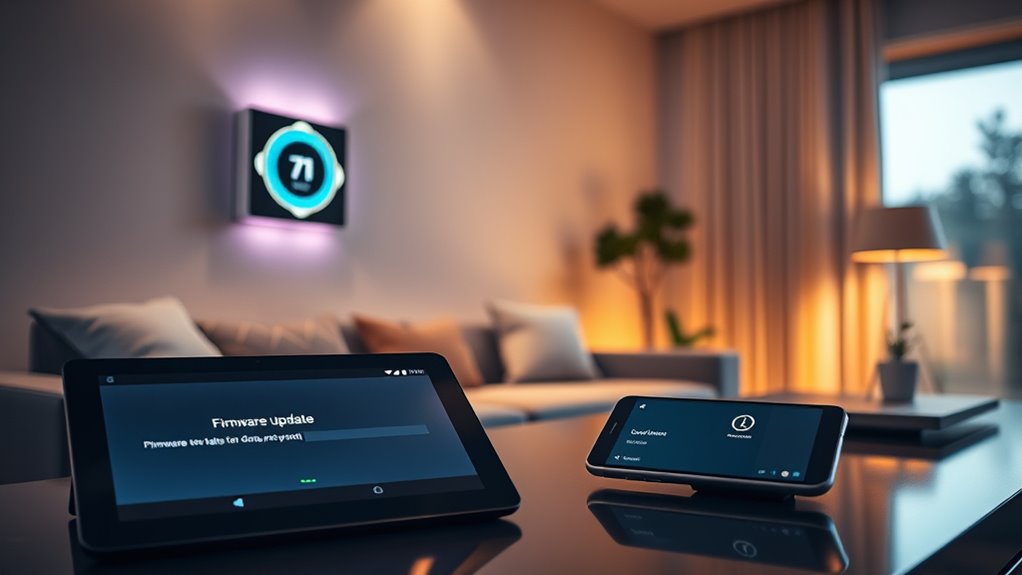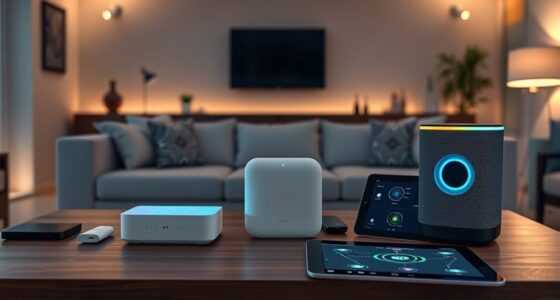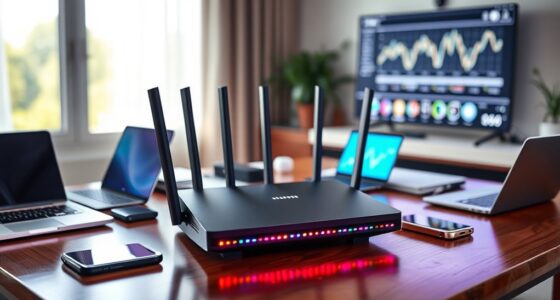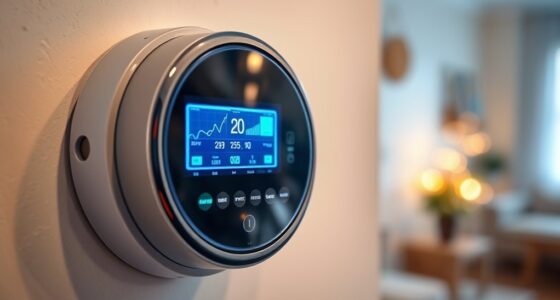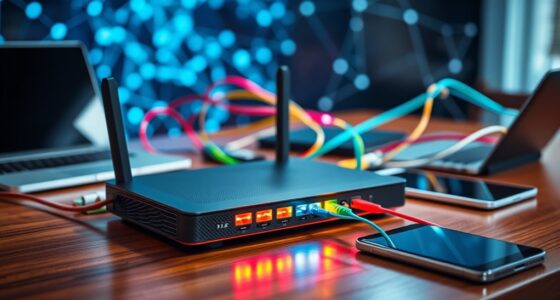Ignoring firmware updates puts your smart home devices at risk by leaving security vulnerabilities unpatched, which cybercriminals can exploit. It can also cause compatibility issues, leading to device malfunctions or connectivity problems that disrupt your daily routines. Updates often include performance improvements and bug fixes, so skipping them means missing out on better speed and reliability. Continuing to ignore these updates can compromise your entire smart home ecosystem; further details reveal why staying current is essential.
Key Takeaways
- Ignoring firmware updates leaves your devices vulnerable to security breaches and cyberattacks.
- Outdated firmware can cause compatibility issues, disrupting device connectivity and functionality.
- Missing updates prevents access to performance improvements and bug fixes, reducing device efficiency.
- Neglecting updates increases the risk of system instability and operational failures.
- Failing to update compromises the overall security and stability of your smart home ecosystem.
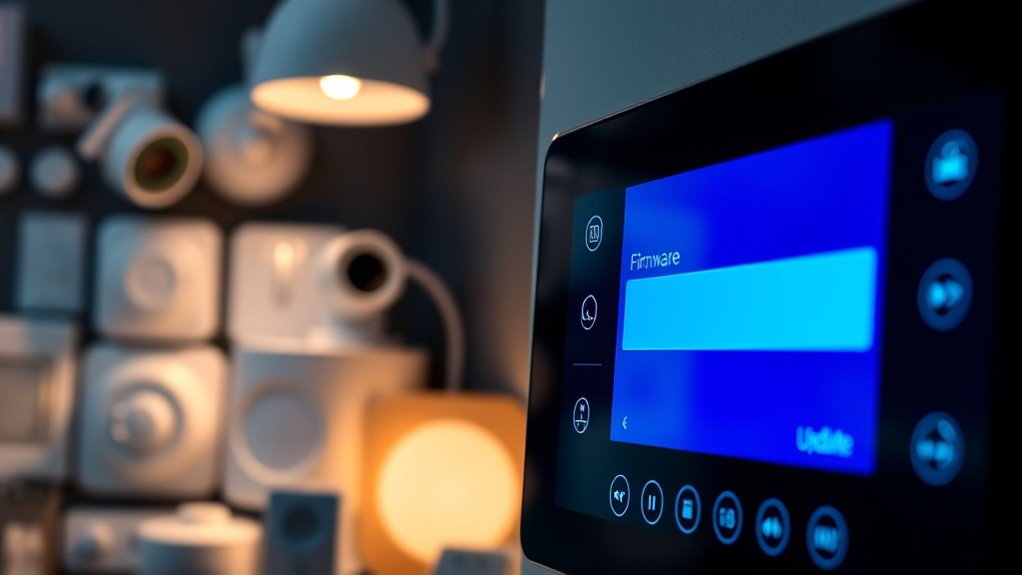
Have you ever wondered why your devices occasionally prompt you to install firmware updates? These notifications might seem like minor annoyances, but they’re actually vital for keeping your smart home secure and functioning smoothly. Firmware updates are designed to patch security vulnerabilities that could otherwise be exploited by hackers or malicious software. Ignoring these updates leaves your devices open to potential threats, putting your personal data and privacy at risk. Cybercriminals are constantly seeking weaknesses in outdated firmware, and failing to update can leave your entire smart home ecosystem vulnerable.
Firmware updates fix security holes and protect your smart home from cyber threats. Stay current to keep your devices safe.
Another key reason to stay on top of firmware updates is device compatibility. Manufacturers frequently release updates to improve how their devices work with other gadgets and platforms. Over time, hardware or software changes may cause compatibility issues if you don’t install the latest firmware. An outdated firmware might prevent your smart home devices from communicating properly, leading to connectivity problems or reduced functionality. For example, a smart lock might not respond promptly, or a security camera might fail to stream footage reliably. Keeping firmware current ensures your devices work as intended, maintaining a seamless and integrated experience across all your gadgets.
Beyond security vulnerabilities and device compatibility, firmware updates often introduce important performance enhancements. These improvements can make your devices faster, more reliable, and more energy-efficient. Sometimes, they fix bugs that could cause crashes or glitches, reducing frustration and downtime. By installing updates promptly, you ensure your smart home operates at peak efficiency, providing peace of mind and convenience. Delaying updates might mean missing out on these benefits, and over time, outdated firmware can cause compatibility conflicts with newer devices or software updates, further complicating your smart home setup.
It’s easy to overlook firmware updates when they pop up unexpectedly, but making it a habit to review and install them can save you headaches later. Many devices now support automatic updates, so you don’t have to remember to do it manually. If your devices don’t update automatically, checking for updates regularly will help you stay protected and ensure everything runs smoothly. Remember, firmware updates are not just about new features—they’re essential for maintaining the security, compatibility, and efficiency of your smart home. Ignoring them might seem harmless in the short term, but over time, it can compromise your system’s stability and security, turning your smart home into a vulnerable and unreliable environment. Staying proactive about firmware updates is one of the simplest yet most effective ways to safeguard and optimize your connected home. Additionally, regular updates can help mitigate potential security vulnerabilities before they can be exploited by cybercriminals.
Frequently Asked Questions
How Often Should I Check for Firmware Updates?
You should check for firmware updates regularly, ideally once a month, to maintain device compatibility and security. Many devices have automatic update scheduling, but it’s smart to verify manually if updates are pending. Staying on top of updates ensures your smart home functions smoothly, reduces security risks, and keeps your devices compatible with the latest features. Don’t ignore update prompts—prompt action keeps your smart home efficient and safe.
Can I Update Firmware Manually or Automatically?
Think of firmware updates like tending to a garden; both manual and automatic updates help your smart home flourish. You can manually update firmware when you want control, often through device settings or a dedicated app. Alternatively, automatic updates act like a gentle rain, ensuring your devices stay current without your intervention. Both methods keep your smart home resilient, secure, and running smoothly, so choose what fits your style best.
What Are the Signs of Outdated Firmware?
You’ll notice signs of outdated firmware when your devices experience compatibility issues, such as failing to connect or malfunctioning. Sometimes, you’ll see update notifications, but if you ignore them, your device might become less secure or less efficient. Check your update notification settings regularly to guarantee you stay informed. Staying on top of firmware updates helps maintain peak performance and security, preventing potential problems down the line.
Do Firmware Updates Improve Device Security?
You might wonder if firmware updates improve device security. They do—by fixing vulnerabilities that hackers could exploit. For example, a smart camera with outdated firmware was hacked, exposing private footage. Updating firmware enhances device encryption and strengthens hacking prevention. Regular updates guarantee your smart home stays protected, preventing unauthorized access and keeping your data safe from cyber threats. Don’t delay—stay current to maintain a secure home environment.
What Happens if a Firmware Update Fails?
If a firmware update fails, you might face firmware corruption or compatibility issues, which can disable your device or cause it to malfunction. You could lose access to essential features or even brick the device entirely. To prevent this, make certain your device has a stable power source and a reliable internet connection during updates. If problems occur, contact customer support or try resetting the device to restore functionality.
Conclusion
Ignoring firmware updates is like leaving a garden unwatered—your smart home can quickly become overgrown with vulnerabilities. By staying current, you’re tending to the health of your devices, ensuring they’re resilient and secure. Don’t let neglect turn your smart home into a neglected backyard. Keep your firmware fresh, and your digital landscape will flourish, safe from pests and storms. Stay proactive, and your smart home will thrive like a well-tended garden.
